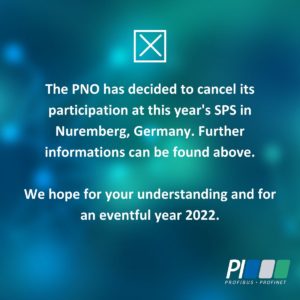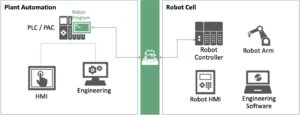 This year is not the usual year in PI’s history. So was the year before. When writing this editorial, I should have been at SPS fair to show all the exciting new work we accomplished over the last months and for quite a while it looked like, we can get back to normal. Meet colleagues, business partners and friends in person. Chat about our technology. But life had different plans and so I am stuck in home-office for another week writing to you from here. Nevertheless, I would like to tell you what you would have seen at the fair. In our second COVID-19 year we found our way how to deal with the situation and still get things done. Working Group meetings were held, specifications and guidelines were written, and demonstrators were built.
This year is not the usual year in PI’s history. So was the year before. When writing this editorial, I should have been at SPS fair to show all the exciting new work we accomplished over the last months and for quite a while it looked like, we can get back to normal. Meet colleagues, business partners and friends in person. Chat about our technology. But life had different plans and so I am stuck in home-office for another week writing to you from here. Nevertheless, I would like to tell you what you would have seen at the fair. In our second COVID-19 year we found our way how to deal with the situation and still get things done. Working Group meetings were held, specifications and guidelines were written, and demonstrators were built.
Ethernet-APL (Advanced Physical Layer)
 As planned three years ago, 2021 was the year Ethernet-APL was released to the market. It makes me very proud, that we started this project together with 3 other Industrial Communication Organizations, namely Fieldcomm Group, ODVA and OPC Foundation, and finished it in time. This clearly demonstrates that we came a long way from the old fieldbus wars to an era of collaboration. I am sure there will be more projects in the future that we are going to execute together with partner associations.
As planned three years ago, 2021 was the year Ethernet-APL was released to the market. It makes me very proud, that we started this project together with 3 other Industrial Communication Organizations, namely Fieldcomm Group, ODVA and OPC Foundation, and finished it in time. This clearly demonstrates that we came a long way from the old fieldbus wars to an era of collaboration. I am sure there will be more projects in the future that we are going to execute together with partner associations.
SPE (Single Pair Ethernet)
A related activity we just started before the fair is Single Pair Ethernet (SPE). In our Working Groups we are currently evaluating the technology with a focus on real life use-cases and its benefits. Many steps need to be taken to end up with a sound concept, guidelines and specifications for implementing it and checking synergies with other communication standards like IO-Link.
TSN (Time-Sensitive Networking) Demonstrator
Sticking to our core business of industrial communications, another topic that would have been highlighted at the fair: Time Sensitive Networking (TSN). While the first specifications for the usage of TSN in PROFINET were released earlier this year, we put our focus on the adoption of the technology. In close collaboration with tech suppliers and chip vendors, we designed and built a new demonstrator for the fair to showcase the state of the technology and its benefits. The emphasis of the new demo is on features like synchronization, Gbit-Ethernet and Preemption. All three support a robust PROFINET communication under any conditions. The technology is at a readiness level now for device manufactures to start designing it in their products. The new demonstrator already includes first prototypes of vendors and many Dev-Kits from tech suppliers.
PROFINET Community Software Stack
To better promote TSN with PROFINET we started another activity this year: the PROFINET community stack. The idea is to foster an open community which maintains core components of the PROFINET stack in a shared development effort. This will help speed up the go-to-market of PROFINET as well as improve the quality of PROFINET products by using shared components. The source code is targeted at tech suppliers to include it in their Development Kits and adopt it to their hardware and programming APIs.
Information Models
 In the field of information models, we released PROFINET-based Companion Specifications for OPC UA, and finished a whitepaper on our strategy and way forward with semantic models. Omlox on the other hand just released version 2.0 of their spec. This is a very active community with a fast pace in developing a truly open and vendor-independent indoor location standard.
In the field of information models, we released PROFINET-based Companion Specifications for OPC UA, and finished a whitepaper on our strategy and way forward with semantic models. Omlox on the other hand just released version 2.0 of their spec. This is a very active community with a fast pace in developing a truly open and vendor-independent indoor location standard.
Standard Robot Command Interface
 It was planned to have the new technology “Standard Robot Command Interface” show-cased for the first time at our fair booth. This is an exciting activity bridging the world of PLC programming with the field of robot controllers. Today every robot maker has their own interface, so incorporating different brands in a shop floor can be a pain. With the new Robot Command Interface, there is a harmonized layer in between, which makes it easy for users to send robot commands from their PLC program independently of the make of the robot. It is a big step forward in Industrie 4.0 applications.
It was planned to have the new technology “Standard Robot Command Interface” show-cased for the first time at our fair booth. This is an exciting activity bridging the world of PLC programming with the field of robot controllers. Today every robot maker has their own interface, so incorporating different brands in a shop floor can be a pain. With the new Robot Command Interface, there is a harmonized layer in between, which makes it easy for users to send robot commands from their PLC program independently of the make of the robot. It is a big step forward in Industrie 4.0 applications.
MTP (Module Type Package)
And then we planned for another surprise at this fair. NAMUR and ZVEI have selected PI to host the Module Type Package (MTP) technology and help to spread its reach internationally. We are proud of the confidence NAMUR and ZVEI have in our organization. We believe our decades of experience in developing vendor-independent standards, ensuring interoperability through certification and creating a global community will help MTP to grow rapidly in process automation worldwide.
Many Thanks to You
Besides all uncertainty because of the pandemic situation and the difficulties to meet at fairs and events, we made huge progress in developing PI from a traditional fieldbus organization to a true Industrie 4.0 enabler. It is a path we will continue to follow. Finally, I want to thank everyone in the PI community for their efforts in making this happen. It is the hundreds of employees of our member companies in all the Working Groups that drive the PI Community. I wish all of you a peaceful Christmas time and some rest to recharge the batteries. I am looking forward to meeting all of you in the new year again. Please stay safe and healthy!

 Karsten Schneider
Karsten Schneider